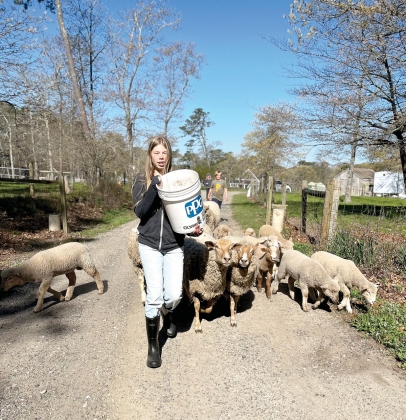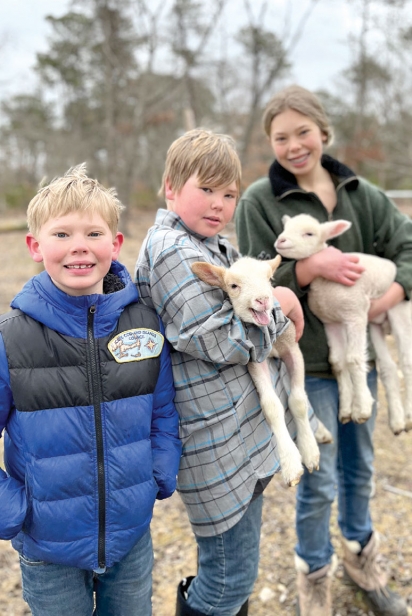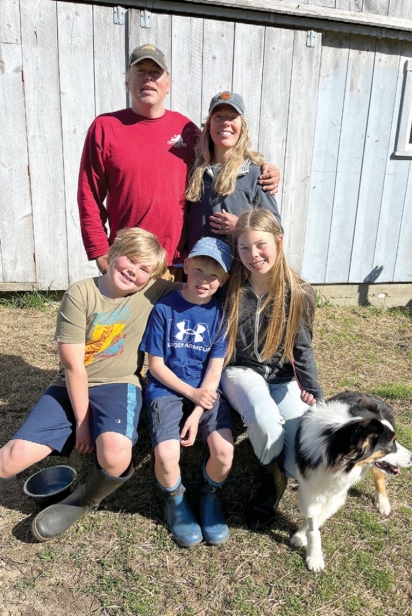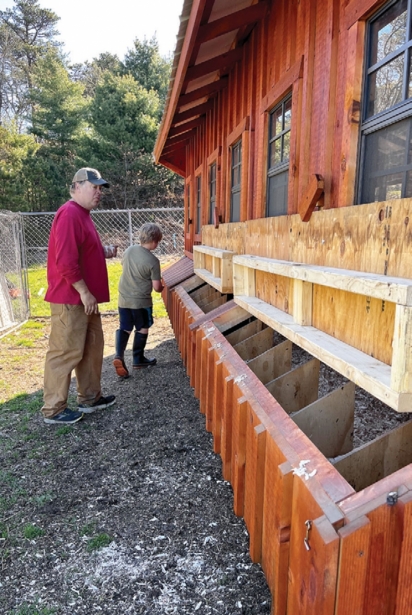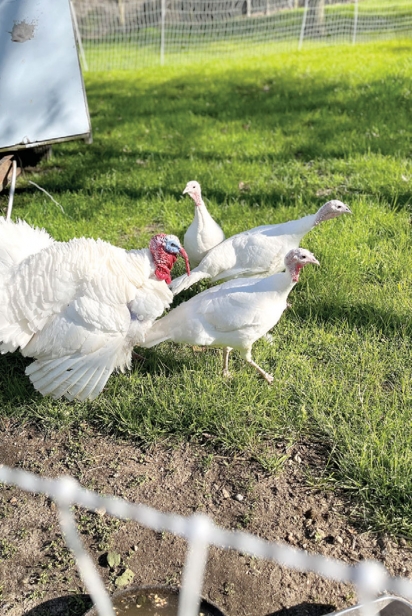Home Sweet Homestead - Raising a Family on a Farm
Travel down the far end of a rutted Brewster lane past a weather-worn stuffed scarecrow dangling from a post, and wire fencing appears. A sheep posse comes into sight, bustling towards approaching visitors. Scrambling to a halt, they poke their fluffy faces into the gridded barrier, baahing their heads off the whole time. A six pack of their week-old kids quickly catches up to their mommas, crowding in to see what’s up. Welcome to the Kaser family’s home.
For most working couples, three children, and a dog or a cat might seem enough. Not for Megan and Bill Kaser. To keep their daughter Kayden and sons Kolby and Chase company, they’ve added nine sheep, nine lambs, four heritage turkeys, two geese and counting, fifty chickens, twenty ducks, 10,000 bees, three cats, three dogs, ten fish, and one bearded dragon.
Bill, a veterinarian and Director of the Brewster Veterinary Hospital, grew up well-steeped in nature and the outdoors, living on property abutting his own that belonged to his parents. In 2001, he lived in a shed on his brother’s land, also adjacent to his own land, while what is now their current house was being built. Megan grew up in Fort Lauderdale yet learned to garden on frequent visits to her grandfather’s land in inland Florida. She now works with her family helping to run The Orleans Inn, a landmark eatery with guest rooms above that they’ve owned for twenty-six years. Megan is about to launch a new venture still in the planning. Bucketfillershop.com will feature apparel and other merchandise sharing the positive values of homesteading. “It may not be for everyone, yet for us, it’s all just a part of how we choose to bring up our family,” says Bill. “It’s a way of life.”
“It’s continual work,” he says, doing chores non-stop as he speaks. “It’s very time consuming and it costs a lot to have it. There’s chicken feed, seeds, portable fencing, chicken tractors, perennial berry and sapling purchases, the shearing of the sheep, maintenance on all the outbuildings, the fees for meat and poultry processing, and lots of hay. In the end, in all of this, if there is any excess product, we may be able to sell it, yet usually it goes to our family and our friends.”
“We eat year-round from the animals we’ve raised, the produce we’ve grown, and the berries we’ve picked right here,” says Megan. “A former vegetarian, I began to eat some meat after meeting Bill, and for me, there were strong health benefits including my skin, which greatly improved. It’s certainly not everyone’s choice, yet if you do consume meat we believe that eating those animals raised freely in a healthy environment and then having a compassionate end to their life is the best decision.”
Beginning by learning to bake, thirteen-year-old daughter Kayden uncovered a passion that’s evolved, and now she prepares half of the family meals. Her mom says, “Food is her love language to our family.“
“Our children are very much aware of the native American ethos of respect for the whole animal, and we practice that in all of our family meals.” They waste very little of the food that is raised here. “We prepare all the parts of an animal, and I then return the bones to a pot to become nourishing bone broth,” says Megan. “Recently I cooked a pork shoulder from a pig we raised, and Chase, our youngest, thought it was the best food ever. Do we occasionally visit a fast-food establishment? Of course, yet it’s a rare occurrence.”
Processing of the animals is done off-site in Rhode Island at a humane processing facility. The Kaser’s two large freezers are stocked with the plastic pouches of different cuts of lamb, pork and meat chickens, heritage turkeys and the occasional duck. “We rotate the packages,” says Bill, “cooking the ones dated earliest first and we like to plan to keep our stock low in the heat of the summer just in case there’s a power outage.”
Megan and kids share in gathering the eggs from both the hens and the ducks. A duck’s eggs, larger in size than chicken eggs, are preferred by some for their richness. Despite production slowing a bit in cooler weather, collecting the eggs daily often yields a basket of 30 or more. She says, “We supply ourselves and family and friends with eggs and sell the rest to our friend Deb Demarais who offers them for sale at her ‘In The Weeds’ farm in Brewster. Its farmstand on Route 6A near the Dennis line is open most days.”
“Then there’s those flying greenhouses,” says Bill, grinning. “Finally, we purchased a great fiberglass greenhouse to use for seed starting and summer growing when a freak windstorm sent it airborne, slamming it upon impact. We never ever break even, how could we? Here goes round two, and this time, I sure didn’t forget to secure its edges under the soil to keep it anchored down. We’ll begin some produce here from seed during the winter, things like lettuce, kale and some herbs. By summer, as long as we keep it well vented for continuous airflow, it’s been great for tomatoes and cucumber plants.”
Like the livestock and the eggs, their family of five plus pets is able to consume a good amount of the fresh produce they grow. Megan experiments with canning, makes some of her own ferments like sauerkraut, which are great for gut health, and freezes lots of berries too. One statistic Bill shares is that if the deliveries of food to Massachusetts stopped (mostly arriving by way of diesel fuel) the state would be out of food in three days. “It’s really up to all of us,” he says, “to support local farming and to make an effort to try and grow and/or raise some of our own food.”
In the years since clearing a hefty section of their eleven-acre parcel of land himself decades ago for their home site, Bill continued to convert areas that were formerly obscured by brush or dotted with trees into open pastureland. The rotation of all the animals through these different fenced-in areas feeds the soil with live biology keeping it fertile, and then the sheep especially will mow down most of the groundcover. Presently on his radar is establishing dense grass cover over several additional fields. “We have a lot of livestock here, and the cost of their feed, for the most part hay, has just skyrocketed. Our animals truly are free ranging; grass fed for most of their diet. Their manure fertilizes the soil, we shear them for wool, and then consume their meat after they’ve lived a happy life here,” he says. “This is actual sustainability in practice.”
Bill submits he’s abandoned their longtime beloved asparagus patch. Its yield was decent, but the man hours needed to clear it yearly wiped out any gain. Visibly relieved of that chore, he displays in an early April visit another stretch of land already prepped for the strawberry plants that he hopes will thrive there. There’s lots of garlic already in, and he points out a stand of prickly berry bushes recently planted – raspberries and blackberries.
By now the entire Kaser clan has gathered in the field with the sheep, their pride clear. They explain that there’s always one ewe who is “the good mother,” keeping track of any wayward little ones. When asked about hand feeding the babies, they jump in explaining that while it’s a rarity on their farm, it’s one task they love. Only if a mom doesn’t have enough milk, which occurs most often in older sheep, do they step in, providing bottles to keep the kids healthy. “Good animal husbandry involves checking to be sure there’s enough milk for the babies,” says Bill. “We aim to breed our sheep most often between the ages of two and seven, although they can begin as early as one year old.”
Rotational grazing of the sheep around the farm serves to keep the parasites that they may harbor in check. Internal parasite eggs are passed by the animals themselves from their intestines through their manure. If the sheep graze each location for 4-5 days, they can move to a new location before the larvae, which take about six days to mature, hatch. Most larvae are also found in the first two inches of height of the grass, so moving on before the grass is chewed down to that level is another strategy. “Plus,” says Bill, “I noticed a worker getting ready to weed whack one of my town’s solar panel gardens. I offered to bring the sheep there to help. It’s great; I lead some of our sheep down the path to graze there around the panels.”
Guarding their hens and ducks from the rats is another challenge. “It’s all about keeping the birds and the coop on the move,” says Bill. “We rotate them around the property every few weeks using portable fencing and a large coop on wheels – a chicken tractor. This prevents the rats from establishing their nests in any one spot. Keeping sightlines open to the owls above is important too, as we know from our camera footage that their nocturnal hunting swoops keep the rodent population in check.”
Much larger than the rats are the coyotes that frequently prowl the Cape and could take out one of the small lambs. Like the owls, they’re documented on film that shows them crisscrossing the farm property each evening. Before dusk, the sheep and their babies must be herded into the barn.
The barn on the property has the innards of one that’s seen a century instead of a decade. “We had it built shortly after we were married in 2008. We were very lucky to get two talented builders, Andrew Shrake and Jessie Lambert, who work on several towns’ historic windmills, to build it for us. It’s a true post and beam barn, built on-site and had a true barn raising where thirty friends and family helped put the beams in place,” says Megan. The entry is on the main floor. It’s all wood – walls, ceiling, and floor. There’s a high planked work bench extending the length of the room with tools on hooks, tools on the floor, tools on all surfaces. A large mound of natural-colored sheep’s wool, streaked with darker gold areas rests in a pile on the floor. Nearby on a table are vines roughly wound into spheres the size of bowling balls. These stiff twiggery structures will be stuffed with wool. Hung in trees, birds pull strands from these nesting balls to carpet their nests with soft warm landing spots for their hatchling babies.
Wooden stairs lead to the top floor. More loft-like than attic, its resident barn cat snoozes in a pool of sunlight. While speaking, Bill opens two cans of food, slipping the first into the cage of a kitten they’ve just adopted into their family. “These should keep the mice in check,” he says.
Scrambling back downstairs, this time down two flights, we step onto the hay-covered floor of the lowest level of the structure, where the sheep sleep. They enter the garage-sized space through barn doors directly from the field outside. There’s a small window letting in a smidgen of light, illuminating where the sheep and the babies will tuck in for the night.
Finally, in a weathered trunk just like one you’d imagine in a barn, Bill rifles through clippings and keepsake treasures he’s saved. Not immediately able to retrieve the hand-written journal he’s looking for, he instead describes it, “I enjoy reading my grandfather’s words about things on his land, “ smiles Bill, “like the weather a century ago.”
Back outdoors, you can’t miss the large white fowl squawking for attention from their large pen. “These are Holland whites,” says Bill, “a variety of heritage turkey. Most turkeys that the public purchases now are artificially inseminated, but this variety reproduces on their own, and they’re delicious. We eat about half of what we raise, sell a few, and trade a few.”
Perhaps his devotion to their farm is precisely the reason Kaser continues to be a beloved caregiver to so many clients and their animals. One might not be aware that the career he’s chosen is highly susceptible to burnout, exhaustion, and depression due to its high physical workloads, ethical conflicts in treatment options and client expectations. “I always send him off to start his day with a healthful smoothie that includes kale, berries, bananas and anything we can harvest from the farm,” says Megan.
“In spring, as the weather first begins to warm, I can’t get everything done,” says Bill. “I seem to be out here every waking hour when I’m not at work as a vet yet I love doing it. My morning chores are my meditating quiet times,” says Bill, “They center and ground me and bring me back to a place of empathy. I never tire of these animals.”
In the final moments of the tour several sheep line up, waiting at the bottom of a slope. All perfectly poised, they gaze our way as if ready to baah their goodbyes. “These four are older and they won’t have any more kids, but this is still their home now,” says Bill.
Kayden points out one of the four with the unruly-iest curls. “She became an accidental house pet when her mom didn’t produce enough milk,” says Megan. “We bottle fed her and she slept inside with us in a dog bed.”
“That’s Sweet Pea,” smiles Kayden. “She’s just my favorite.”
Writer Michelle Koch has two adult daughters and works at the Brewster Book Store, where you can find bouquets of flowers she’s grown. She had a blast meeting the Kaser family and visiting their homestead.


